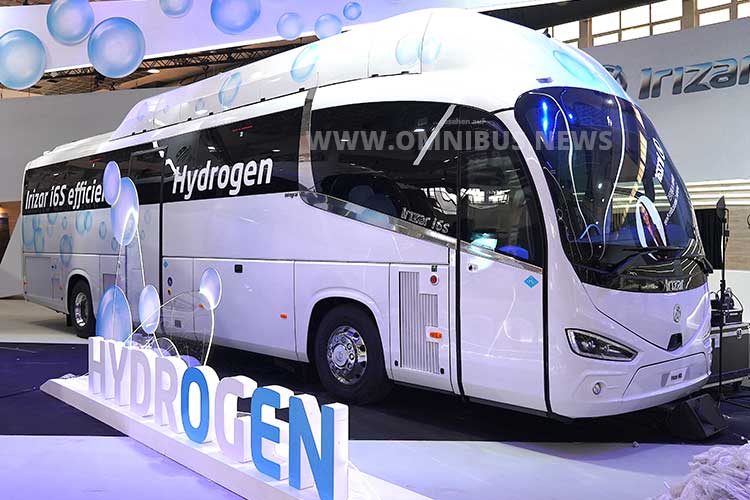
With the i6S Efficient Hydrogen, Irizar presented a proof-of-concept vehicle for the FCEV coach segment at Busworld. Mit dem i6S Efficient Hydrogen hat Irizar auf der Busworld ein Proof-of-Concept-Fahrzeug für das Segment der FCEV-Reisebusse präsentiert. Foto/photo: Schreiber
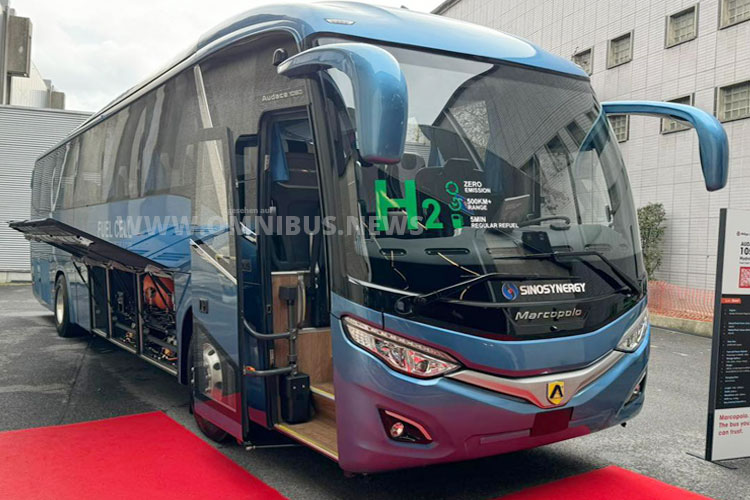
The alliance of Marcopolo from Brazil, the Chinese fuel cell module supplier Sinosynergy and the bus manufacturer Allenbus (also from China) exhibited an FCEV coach on the outdoor area of Busworld. Auf dem Außengelände der Busworld stellte die Allianz von Marcopolo aus Brasilien, dem chinesischen Brennstoffzellenmodul-Lieferanten Sinosynergy und dem ebenfalls chinesische) Bushersteller Allenbus einen FCEV-Reisebus aus. Foto/photo: Schreiber
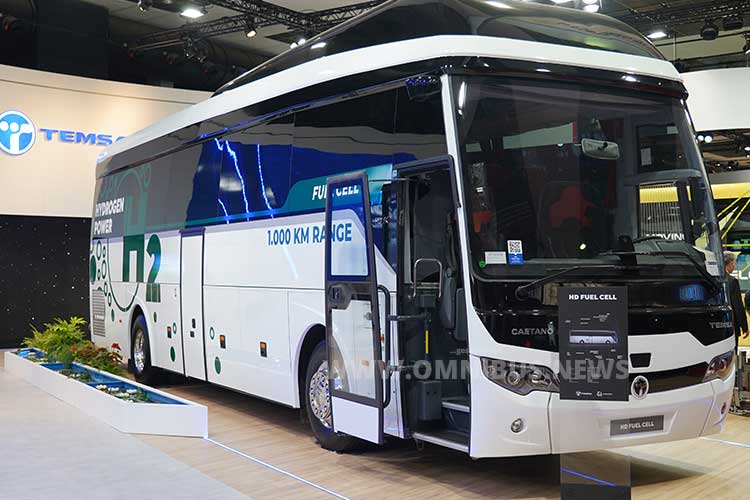
Temsa also put an FCEV coach based on the HD series in the spotlight at Busworld. Auch Temsa rückte einen FCEV-Reisebus auf Basis der HD-Baureihe auf der Busworld ins Rampenlicht. Foto/photo: Schreiber
Over 40,000 visitors attended this year’s Busworld, the bus industry’s leading trade fair. In Brussels, a total of 222 buses and coaches were exhibited in the Expositiehallen van Brussel, plus 29 in the outdoor area. Here, for example, you could discover an old acquaintance, not quite in the spotlight, but present at Busworld: after its European premiere at the IAA Transportation 2022 in Hanover, the FCEV coach was on display here, which is produced by the alliance of Marcopolo from Brazil, the Chinese fuel cell module supplier Sinosynergy and the bus manufacturer Allenbus, also from China.
Irizar and Temsa also exhibited an FCEV coach. The basis in each case is the corresponding vehicle from large-scale production. Up to 53 passengers can travel in the Audace 1050, which Marcopolo manufactures in China. The passenger compartment is fitted out individually according to customer requirements. Two 80 kW fuel cell modules from Sinosynergy are on board, which are powered by a 141 kWh battery from CATL and a motor from Danfoss. Allianz states that the storage capacity is 38 kg of hydrogen, which is compressed at 350 bar. The FCEV coach is based on the Audace 1050 model from Marcopolo, which is built in China. The bus on display had a length of 12 meters, but 11.9 m, 12.3 m or 12.6 m are also available – the wheelbase is between 6,100 and 6,650 mm, the width is 2.5 m and the height is 3.7 m. There is nothing new in terms of technology after Hanover, the drive motor has a rated output of 143 kW (peak 235 kW) and a rated torque of 495 Nm (peak 720 Nm).
The fuel cell from Sinosynergy (type G80-001) is supplemented with four CATL LiFeO storage batteries (lithium-iron type). Four hydrogen tanks (currently still designed for 700 bar, 350 bar is easily achievable) in the luggage compartment of the bus store the hydrogen. The Chinese alliance is using a ZF make (type RL82EC) for the front axle and ZF (type AV133) for the driven rear axle. The automatic transmission (type THP90) also comes from ZF. The air suspension and braking technology with EBS, ESP, AEB and LDWS come from Knorr.
With the i6S Efficient Hydrogen, Irizar presented a proof-of-concept vehicle of a fuel cell electric coach at Busworld and is once again ahead of its time. It was a similar story in 2011, when the Spanish commercial vehicle manufacturer based in Ormaiztegi, Basque Country, decided to develop electric buses. Irizar is open to all technologies and focuses on BEV and FCEV buses. Imanol Rego, CEO of the Irizar Group, sees hydrogen as the likely solution for zero-emission coaches, as he explained during the presentation of the i6S Efficient Hydrogen at Busworld
If customers were to order FCEV coaches from Irizar today, a small series would initially be produced, which would probably be available from the end of next year. Regarding the technical details of the proof-of-concept vehicle: a locally emission-free range of up to 1,000 km with a refueling time of around 20 minutes is already feasible, according to Rego. The purchased fuel cell generates a peak output of 200 kW, while the in-house electric motor has a peak output of 400 kW and a continuous output of 360 kW with 1,360 Nm. On board are batteries with a capacity of 60 kW/h, which can provide a boost when high power is required and would be recharged at other times and by regenerative braking or by the fuel cell.
56 kg of hydrogen can be stored at 350 bar. However, up to 78 kg of hydrogen would be possible in a three-axle vehicle. However, precise details on the weight increase of the i6S Efficient Hydrogen compared to the i6S Efficient could not or would not be given at the trade fair. 1,864 kW/h of energy is stored in the tanks, and yes, the engineers at Irizar are aware that some of this is lost on the way to the wheel. Nevertheless, they have built a proof-of-concept vehicle to test the technology in all areas because there will very probably be a politically desirable market for it in Europe. In this context, Imanol Rego also pointed out that they are looking into the possibility of using 700 bar.
The tanks are installed on the roof and the capacity of the luggage compartments remains fully intact, as Irizar reports. The fuel cell has been placed in the rear, in the former engine compartment. The height of the i6S Efficient Hydrogen shown at Busworld measures four meters in the proof-of-concept vehicle, with a length of 12.92 meters and a width of 2.55 meters. There are 49 seats on board, plus one each for the driver and tour guide. There is also a wheelchair space and a lift is provided at the middle door in the stairwell area. Temsa wants to deliver an FCEV coach to customers in 2025 – not only the statement, but also the bus presented at Busworld on the basis of the HD series with the support of Caetano Bus was a real eye-catcher – if you look at the drive system. Tolga Kaan Doğancıoğlu admitted openly and honestly that the range would vary depending on the location and climatic conditions, but that the 1,000 km was achievable. „One of the challenges is the range. So if we want to talk about a revolution in locally emission-free buses, we have to be open to technology and talk about battery-electric and hydrogen-powered vehicles.“
The FCEV coach from Temsa is designed for up to 53 passengers, is optionally available with 350/700 bar and runs on 72.8 kg of hydrogen on board, according to Tolga Kaan Doğancıoğlu, CEO of Temsa, in an interview with omnibus.news. There are also batteries with 160 kWh, which can provide a boost when high power is required (they are charged by regenerative braking or by the fuel cell). The fuel cell has an expected service life of 35,000 hours. The FCEV coach prototype is powered by a TM Sumo HD4 engine with an output of 350 kW. The hydrogen tanks are located at the front of the bus, while the Toyota fuel cell is located at the rear, where an engine would otherwise be. The passenger compartment, like the driver’s workplace, is largely identical to that of the HD12 – the only new feature is a digital dashboard that also displays specific information for the hydrogen drive.
The FCEV coaches on display at Busworld put the onus on politicians to get the necessary charging infrastructure up and running. „We can deliver,“ says Imanol Rego, CEO of the Irizar Group, full of pride. But despite the commitment of Irizar, Marcopolo and Temsa, we must remain realistic and say that the e-coach market will not be an exciting reality until the end of the decade. The coach market has a future, still with diesel engines, no question!
The three FCEV coaches are gems that the manufacturers put in the spotlight in Brussels. And the preview at the VDL stand made it clear: you have to be open to the future of coaches in terms of technology. The next Futura series, which the Dutch company will present next year, will be launched with a classic diesel engine! But then also as a BEV and FCEV coach, depending on what the market allows and wants, as VDL explained. (Busworld/Irizar/Marcopolo/Temsa/VDL/PM/omnibus.news/Sr)
Deutsche Fassung:
Über 40.000 Besucher waren in diesem Jahr auf der Busworld, der Leitmesse der Busbranche, vor Ort. In Brüssel wurden in den Expositiehallen van Brussel insgesamt 222 Omnibusse ausgestellt, dazu noch 29 im Freigelände. Hier konnte man beispielsweise einen alten Bekannten entdecken, nicht ganz im Rampenlicht, aber auf der Busworld dabei: Nach der Europapremiere auf der IAA Transportation 2022 in Hannover stand hier der FCEV-Reisebus, der von der Allianz von Marcopolo aus Brasilien, dem chinesischen Brennstoffzellenmodul-Lieferanten Sinosynergy und dem ebenfalls chinesische) Bushersteller Allenbus hergestellt wird.
Auch Irizar und Temsa stellten einen FCEV-Reisebus aus. Grundlage ist jeweils das entsprechende Fahrzeug aus der Großserie. Bis zu 53 Passagiere können im Audace 1050, den Marcopolo in China fertigt, mitfahren. Die Ausstattung des Fahrgastraumes erfolge individuell nach Kundenwunsch. Zwei 80-kW-Brennstoffzellenmodule von Sinosynergy sind an Bord, die mit einer 141-kWh-Batterie von CATL und einem Motor von Danfoss betrieben werden.
Als Speicherkapazität nennt die Allianz 38 kg Wasserstoff, der bei 350 bar komprimiert wird. Der FCEV-Reisebus basiert auf dem Modell Audace 1050 von Marcopolo, das in China gebaut wird. Der ausgestellte Bus hatte eine Länge von 12 Metern, lieferbar sind auch 11,9m, 12,3m oder 12,6m – der Radstand liegt bei 6.100 bis 6.650 mm, die Breite beträgt 2,5 m, die Höhe von 3,7 m. Neues im Bereich der Technik gibt es nach Hannover nicht, der Antriebsmotor hat eine Nennleistung von 143 kW (Spitze 235 kW) und ein Nenndrehmoment von 495 Nm (Spitze 720 Nm).
Die Brennstoffzelle von Sinosynergy (Typ G80-001) wird mit vier CATL LiFeO Speicherbatterien (Lithium-Eisen-Bauart) ergänzt. Vier Wasserstofftanks (aktuell noch für 700 bar ausgelegt, 350 bar seien problemlos darstellbar) im Gepäckraum des Omnibusses halten den Wasserstoff vor. Als Vorderachse greift die chinesische Allianz auf ein Fabrikat von ZF (Typ RL82EC) zurück, bei der angetriebenen Hinterachse ist es auch ZF /Typ AV133). Auch das Automatikgetriebe (Typ THP90) stammt von ZF. Die Luftfederung sowie die Bremstechnik mit EBS, ESP, AEB, LDWS stammt von Knorr.
Irizar hat mit dem i6S Efficient Hydrogen auf der Busworld ein Proof-of-Concept-Fahrzeug eines brennstoffzellenelektrischen Reisebusses vorgestellt und ist damit wieder einmal der Zeit voraus. Ähnlich war es 2011, denn da entschied sich der spanische Nutzfahrzeughersteller mit Sitz im baskischen Ormaiztegi, Elektrobusse zu entwickeln. Bei Irizar gobt man sich technologieoffen und setzt auf BEV- und FCEV-Omnibusse. Imanol Rego, CEO der Irizar Gruppe, sieht Wasserstoff als die wahrscheinliche Lösung für emissionsfreie Reisebusse an, wie er im Rahmen der Vorstellung des i6S Efficient Hydrogen auf der Busworld erklärte.
Wenn Kunden heute FCEV-Reisebusse bei Irizar bestellen würden, dann werde man zunächst eine Kleinserie auflegen, die vermutlich ab Ende des nächsten Jahres verfügbar wäre. Zu den technischen Details des Proof-of-Concept-Fahrzeugs: Eine lokal emissionsfreie Reichweite von bis zu 1.000 km bei einer Betankungszeit von etwa 20 Minuten sei schon jetzt darstellbar, so Rego. Die zugekaufte Brennstoffzelle erzeuge eine Spitzenleistung von 200 kW, der verbaute hauseigene Elektromotor habe eine Spitzenleistung von 400 kW und eine Dauerleistung von 360 kW mit 1.360 Nm. Mit an Bord sind Batterien mit einer Leistung von 60 kW/h, diese können bei hohem Leistungsbedarf einen Boost liefern und würden zu anderen Zeiten sowie durch regeneratives Bremsen oder von der Brennstoffzelle aufgeladen werden.
56 kg Wasserstoff können bei 350 bar gespeichert werden. Möglich wären bei einem Dreiachser aber bis zu 78 kg Wasserstoff. Genaue Angaben zur Gewichtszunahme des i6S Efficient Hydrogen im Vergleich zum i6S Efficient konnte oder wollte man auf der Messe aber nicht machen. 1.864 kW/h an Energie seien in den Tanks gespeichert, und ja, den Ingenieuren bei Irizar wäre bewusst, dass ein Teil davon auf dem Weg zum Rad verloren gehe. Man habe dennoch ein Proof-of-Concept-Fahrzeug gebaut, um die Technik in allen Bereichen erproben zu können, weil es sehr wahrscheinlich einen politisch gewollten Markt in Europa dafür geben werde. Imanol Rego verweis in diesem Zusammenhang noch darauf, dass man prüfe, auch 700 bar darzustellen.
Die Tanks sind auf dem Dach verbaut, die Kapazität der Gepäckräume bleibt vollumfänglich erhalten, wie Irizar mitteilt. Die Brennstoffzelle wurde im Heck, im ehemaligen Motorraum platziert. Die Höhe des auf der Busworld gezeigten i6S Efficient Hydrogen misst im Proof-Concept-Fahrzeug vier Meter, die Länge 12,92m und die Breit 2,55m. 49 Sitzplätze und je einer für Fahrer und Reiseleiter sind an Bord. Dazu noch ein Rollstuhlplatz, ein Lift wird an der mittleren Tür im Treppenbereich vorgehalten.
2025 will Temsa einen FCEV-Reisebus an Kunden ausliefern – nicht nur die Aussage, sondern auch der auf Basis der HD-Baureihe mit Unterstützung von Caetano Bus vorgestellte Omnibus war auf der Busworld ein echter Knaller – wenn man den Antrieb sieht. Offen und ehrlich gab Tolga Kaan Doğancıoğlu zu, dass die Reichweite unter Berücksichtigung des Einsatzortes und der klimatischen Verhältnisse variieren werde, die 1.000 km seien aber darstellbar. “Eine der Herausforderungen ist die Reichweite. Wenn wir also von einer Revolution der lokal emissionsfreien Omnibusse sprechen wollen, müssen wir technologieoffen sein und über batterieelektrische wie wasserstoffbetriebene Fahrzeuge sprechen.”
Der FCEV-Reisebus von Temsa sei für bis zu 53 Fahrgäste gedacht, wahlweise mit 350/700bar verfügbar und mit 72,8 kg Wasserstoff an Bord unterwegs, so Tolga Kaan Doğancıoğlu, CEO von Temsa, im Gespräch mit omnibus.news. Zusätzlich gibt es noch Batterien mit 160 kWh, diese können bei hohem Leistungsbedarf einen Boost liefern (geladen werden sie durch regeneratives Bremsen oder von der Brennstoffzelle). Die Brennstoffzelle hat eine voraussichtliche Lebensdauer von 35.000 Stunden. Angetrieben wird der FCEV-Reisebus-Prototyp von einem TM Sumo HD4-Motor mit einer Leistung von 350 kW. Die Wasserstofftanks befinden sich an der Vorderseite des Omnibusses, die Brennstoffzelle von Toyota befindet sich am Heck, wo sonst ein Motor wäre. Der Fahrgastraum ist, wie auch der Fahrerarbeitsplatz, weitgehend mit dem des HD12 identisch ist – lediglich ein digitales Armaturenbrett, das auch spezifische Informationen für den Wasserstoffantrieb anzeigt, hat als Neuheit Einzug gehalten.
Die auf der Busworld gezeigten FCEV-Reisebusse nehmen die Politik in die Pflicht, die nötige Ladeinfrastruktur auf den Weg zu bringen. „Wir können liefern“, so Imanol Rego, CEO der Irizar Gruppe, voller Stolz. Aber trotz des Engagements von Irizar, Marcopolo und Temsa muss man realistisch bleiben und sagen, dass der E-Reisebusmarkt erst zum Ende des Jahrzehnts eine spannende Realität sein wird. Der Reisebusmarkt hat eine Zukunft, nach wie vor mit Dieselmotor, keine Frage!
Die drei FCEV-Reisebusse sind Schmuckstücke, die die Hersteller in Brüssel ins Rampenlicht rückten. Und die Preview am Messestand von VDL machte es deutlich: Man muss der Zukunft des Reisebusses gegenüber technologieoffen sein. Die nächste Futura-Baureihe, die die Niederländer im nächsten Jahr vorstellen werden, wird es zum Start mit einem klassischen Dieselmotor geben! Dann aber auch als BEV- und FCEV-Reisebus, je nachdem, was der Markt erlaubt und wünscht, wie VDL erklärte. (Busworld/Irizar/Marcopolo/Temsa/VDL/PM/omnibus.news/Sr)
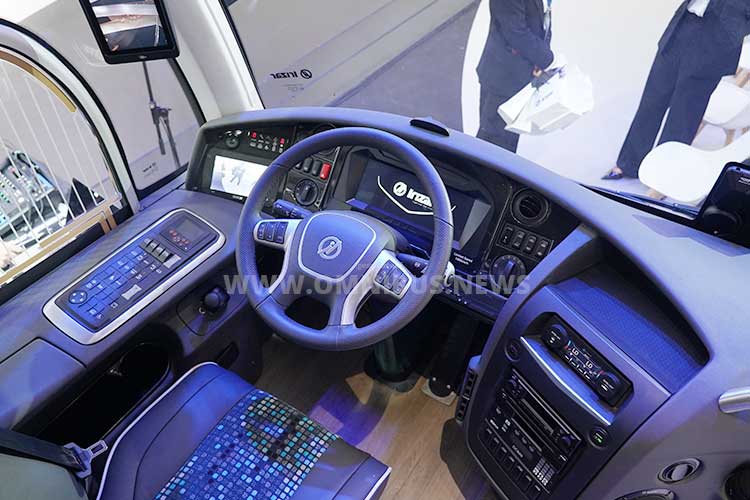
Irizar: The driver’s workplace of the proof-of-concept vehicle corresponds to that of the i6 series vehicles. Irizar: Der Fahrerarbeitsplatz des Proof-of-Concept-Fahrzeugs entspricht dem der i6 Serienfahrzeuge. Foto/photo: Schreiber
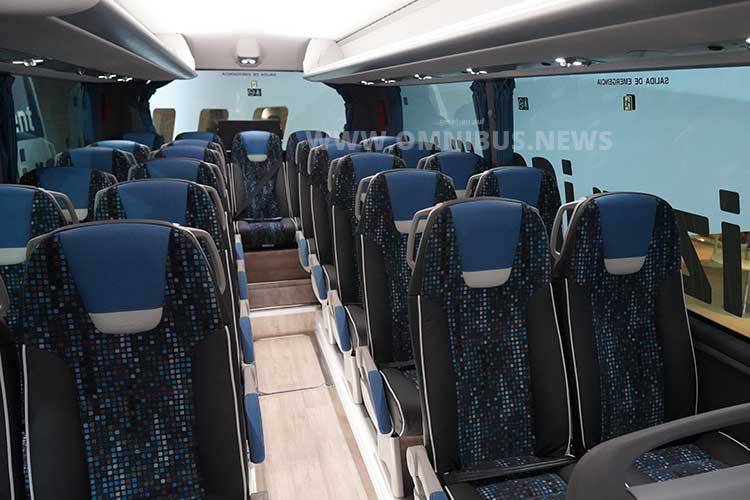
49 seats and one each for the driver and tour guide are on board the Irizar FCEV coach. 49 Sitzplätze und je einer für Fahrer und Reiseleiter sind an Bord des Irizar FCEV-Reisebusses. Foto/photo: Schreiber
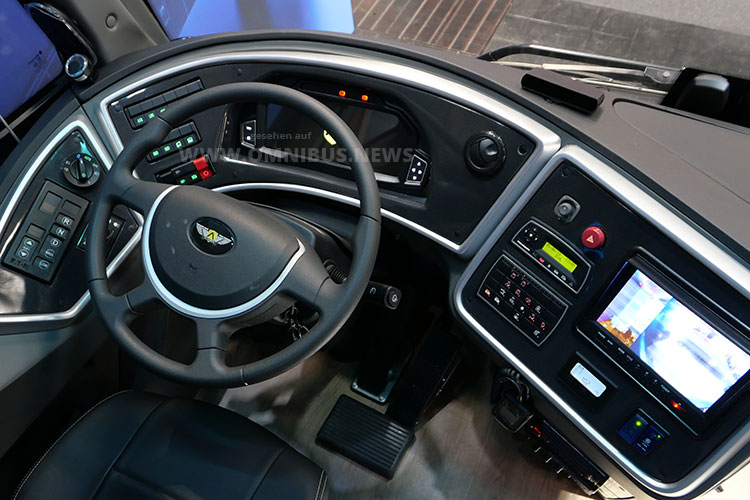
The driver’s workplace of the Marcopolo Audauce Sinosynergy FCEV comes from the large-scale production of the Brazilians. Der Fahrerarbeitsplatz des Marcopolo Audauce Sinosynergy FCEV stammt aus der Großserie der Brasilianer. Foto/photo: Böhnke
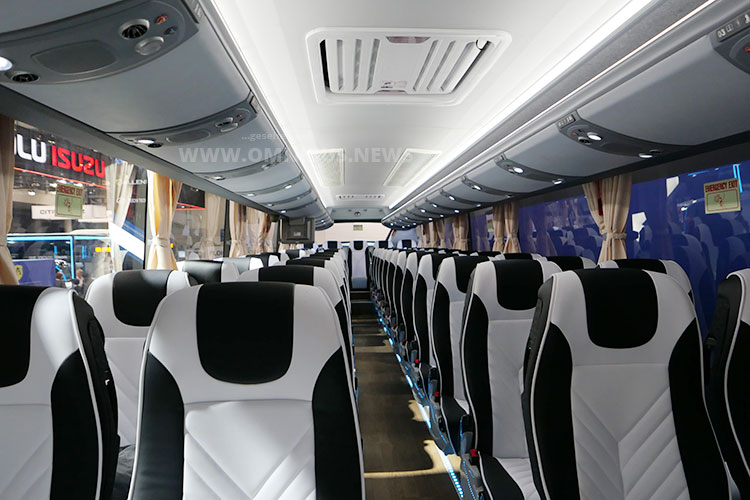
The passenger compartment of the Marcopolo Audauce remains unaffected by the FCEB drive. Der Fahrgastraum des Marcopolo Audauce bleibt durch den FCEB-Antrieb unberührt. Foto/photo: Böhnke

The hydrogen is not carried in tanks on the roof (as in Irizar and Temsa), but behind the luggage compartments of the front axle in Marcopolo. Nicht auf dem Dach (wie bei Irizar und Temsa), sondern hinter den Gepäckfächern der Vorderachse wird der Wasserstoff in Tanks bei Marcopolo mitgeführt. Foto/photo: Böhnke
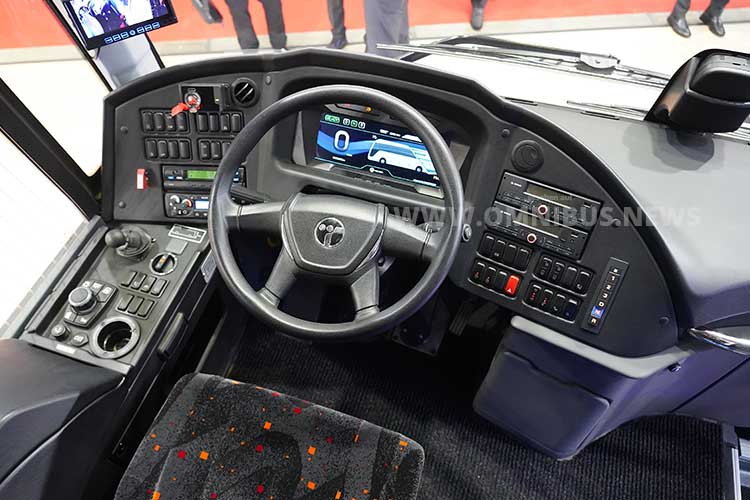
The driver’s workplace is almost identical to that of the HD series – except for the components for the FCEV drive. Der Fahrerarbeitsplatz entspricht fast dem der HD-Baureihe – bis auf die Komponenten für den FCEV-Antrieb. Foto/photo: Schreiber
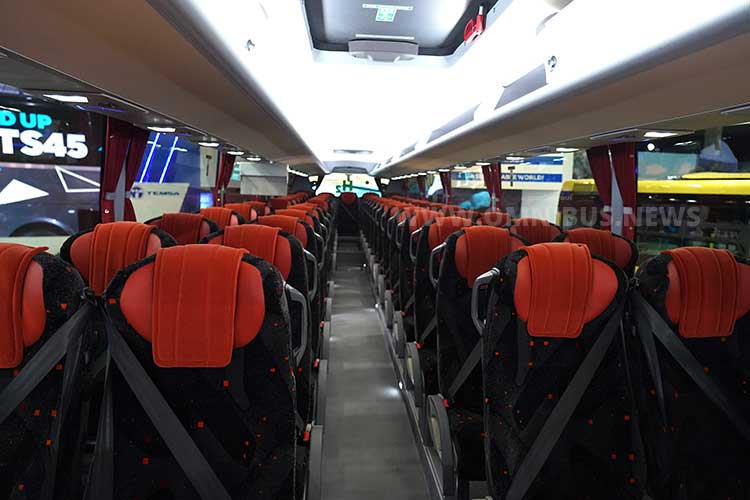
The luggage and passenger compartments (with space for up to 53 passengers) are familiar features that the Temsa FCEV coach also offers. Gepäck- und Fahrgastraum (mit Platz für bis zu 53 Fahrgästen) sind bekannte Größen, die auch der FCEV-Reisebus von Temsa bietet. Foto/photo: Schreiber
